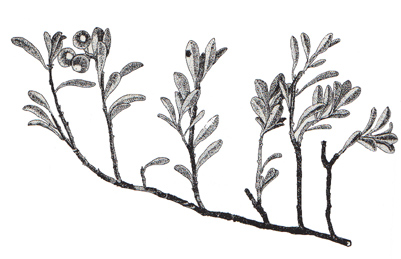

Uva-ursi or Kinnikinnick
Arctostaphylos uva-ursi
(Ericaceae)
Description:
Uva-ursi, also called kinnikinnick or bearberry, is a creeping
to semi-erect shrub. Its long, flexible branches form mats by rooting; the twigs
are covered with hairs. The leaves, about 3/4 inch (2 cm.) long, are evergreen,
leathery, oblong to obovate, light green on the bottom with no brown spots (see
lowbush cranberry), and net-veined. The urn-shaped flowers vary from white to
pink and the fruit is a mealy red berry, seedy and dry but edible.
Distribution:
Mats of uva-ursi are common in the boreal forest region
of Alaska and across Canada in a wide variety of habitats. This plant is also
found in northern Europe and Asia.
Constituents:
The chief medicinal principle of uva-ursi tea is a glycoside
known as arbutin, found in many members of the heather family. (Turner and Czszawinski)
Its other elements are methylarbutin, ursolic acid, tannic acid, gallic acid,
some essential oil, and resin. (Pierson)
Medicinal uses:
The leaves are grown commercially for use as a diuretic
and astringent, and the medicine, marketed under the name Uva Ursi or Bearberry,
has long been used for relieving kidney and bladder problems and Certain constituents
of the uva-ursi leaf combine with chemicals normally found in urine to form
hydroquinone (P-dihydroxybenzene), which is bactericidal. Don't worry if the
urine turns bright green. (Gibbons) Uva-ursi helps to reduce accumulations of
uric acid and to relieve the pain of bladder stones and gravel; use it to alleviate
cystitis.
The tea is known as Kutai, or "Caucasian tea," in Russia. It is popular in many parts of the world as a tonic or health tea, good for stomach and urinary disorders such as bedwetting. Use 1 teaspoon of dried leaves per cup of boiling water and steep for five minutes. Prospectors and trappers recommend soaking the leaves in whiskey first and then using them in the normal way to make tea. (Turner and Czszawinski) The tea or tincture can be used for bronchitis, according to Lust.
The term kinnikinnick is said to be derived from an Algonquin Indian word meaning "smoking mixture." The name has come to be used for Arctostaphylos uva-ursi, whose leaves are often used in smoking mixtures. (Turner and Czszawinski) The Chippewas smoked these leaves as a headache cure.
Lime villagers say uva-ursi berries are good as a laxative. (Kari)
Caution: Excessive, prolonged use should be avoided; in any usage both an aromatic and a demulcent should be added to the leaves, since their action when alone is too irritating.
Copyright © 1987 by Eleanor G. Viereck